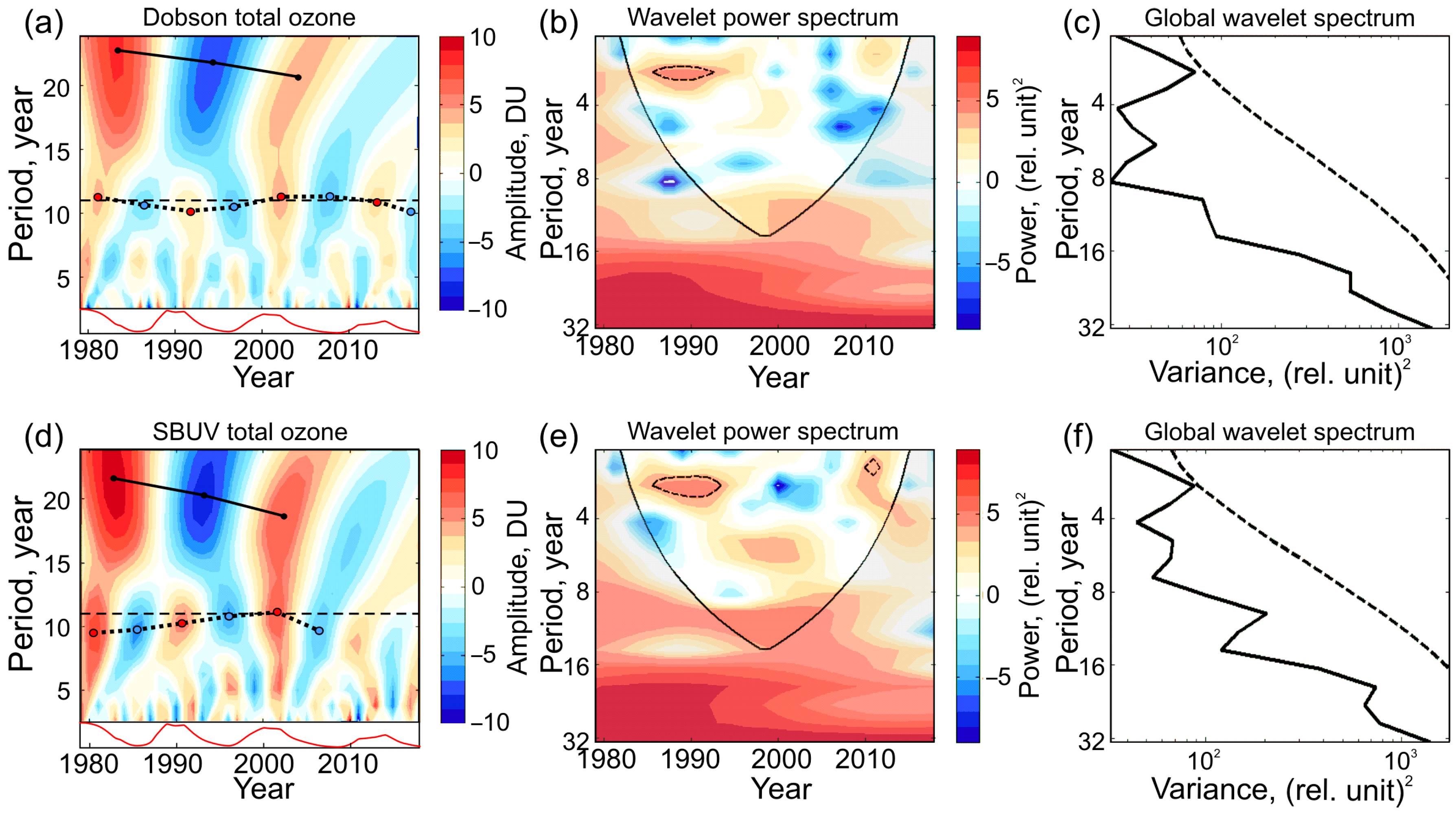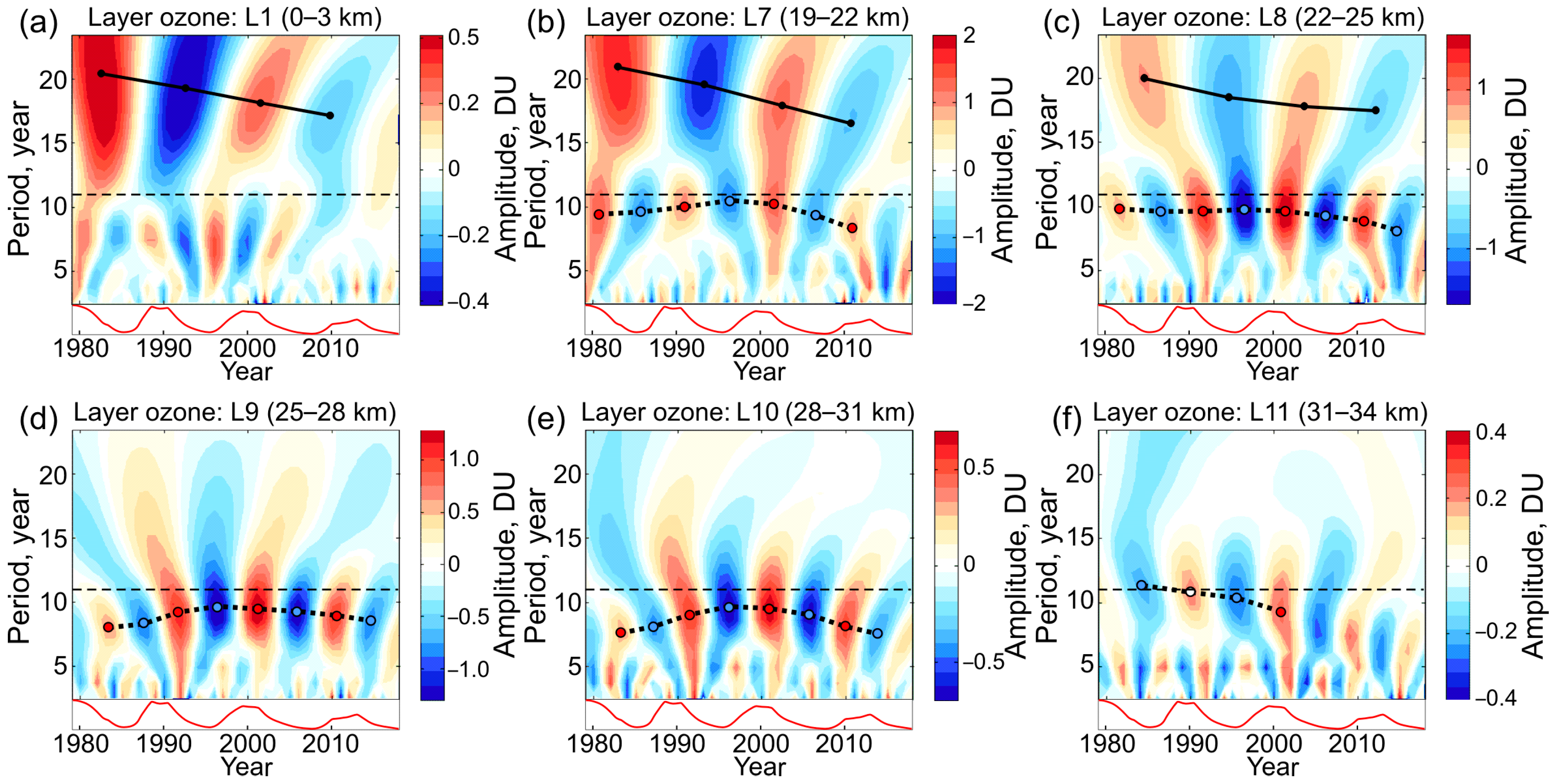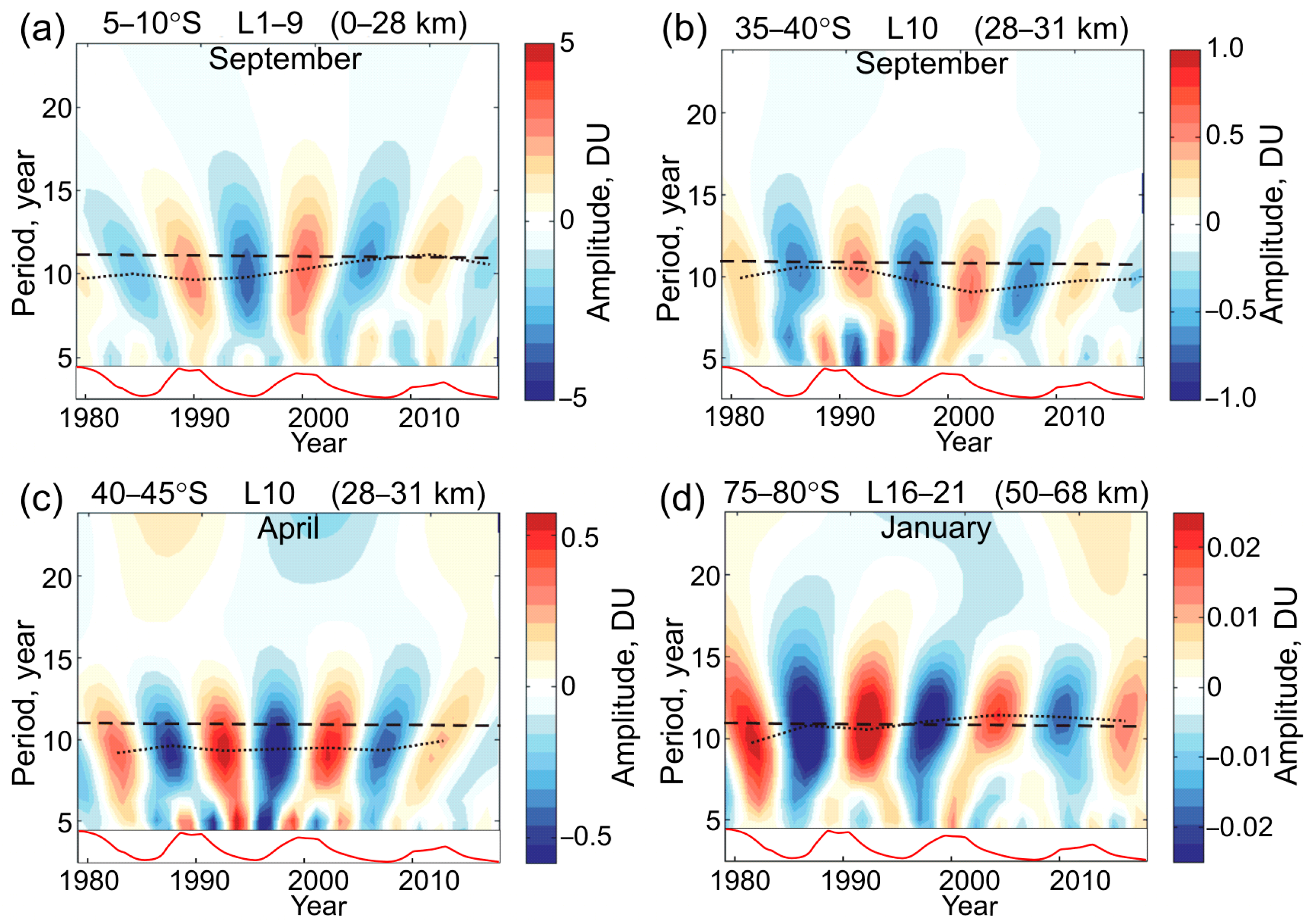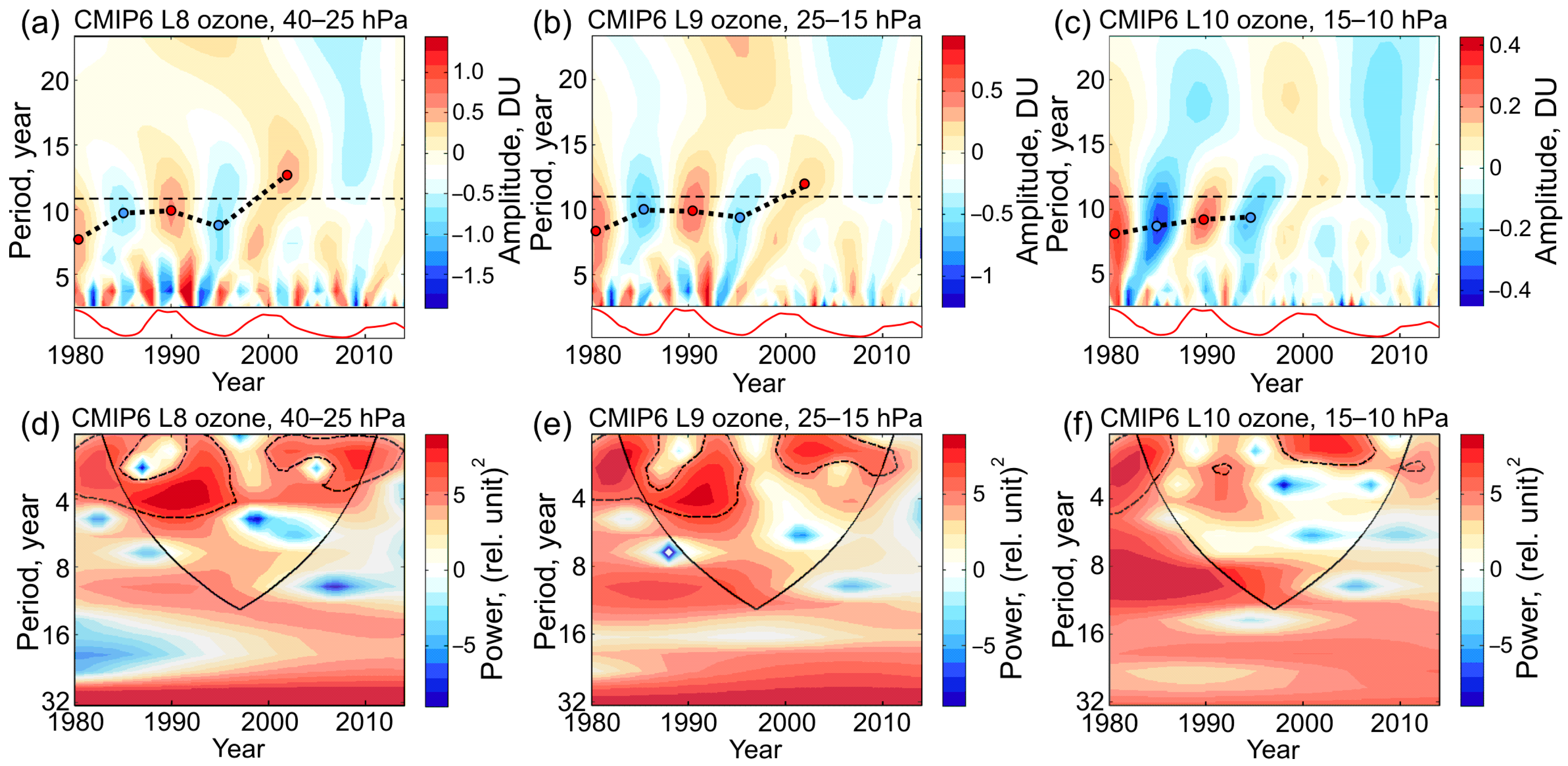Investigation of the Vertical Influence of the 11-Year Solar Cycle on Ozone Using SBUV and Antarctic Ground-Based Measurements and CMIP6 Forcing Data
Abstract
:1. Introduction
2. Data and Methods
3. Results
3.1. Solar Cycles in Sunspot Numbers and 10.7 cm Solar Flux
3.2. Periodicity in Ozone Variations
3.3. Zonal Mean Response
4. Discussion
- Lower SBUV layers L1–L9 in the tropics (0–28 km, Figure 8a);
- Lower–middle stratosphere in the SH extratropics, L9 and L10 (25–31 km, Figure 8b,c);
- Middle–upper stratosphere in the tropics, L11–L15 (31–47 km, Figure 8d,e); and
- Stratopause–lower mesosphere region, L16–L21, mostly in the SH (47–64 km, Figure 8f).
5. Conclusions
Author Contributions
Funding
Acknowledgments
Conflicts of Interest
References
- Rowland, F.S. Stratospheric Ozone Depletion. In Twenty Years of Ozone Decline, Proceedings of the Symposium for the 20th Anniversary of the Montreal Protocol; Zerefos, C., Contopoulos, G., Skalkeas, G., Eds.; Springer: Dodrecht, Germany, 2009; pp. 23–66. [Google Scholar] [CrossRef] [Green Version]
- Solomon, S.; Portmann, R.W.; Sasaki, T.; Hofmann, D.J.; Thompson, D.W.J. Four decades of ozonesonde measurements over Antarctica. J. Geophys. Res. 2005, 110, D21311. [Google Scholar] [CrossRef] [Green Version]
- Fabian, P.; Dameris, M. Ozone in the Atmosphere. Basic Principles, Natural and Human Impacts; Springer: Heidelberg, Germany, 2014; 137p. [Google Scholar] [CrossRef]
- Chipperfield, M.P.; Bekki, S.; Dhomse, S.; Harris, N.R.P.; Hassler, B.; Hossaini, R.; Steinbrecht, W.; Thieblemont, R.; Weber, M. Detecting recovery of the stratospheric ozone layer. Nature 2017, 549, 211–218. [Google Scholar] [CrossRef] [PubMed] [Green Version]
- Grytsai, A.V.; Evtushevsky, O.M.; Agapitov, O.V.; Klekociuk, A.R.; Milinevsky, G.P. Structure and long-term change in the zonal asymmetry in Antarctic total ozone during spring. Ann. Geophys. 2007, 25, 361–374. [Google Scholar] [CrossRef]
- Kuttippurath, J.; Nair, P.J. The signs of Antarctic ozone recovery. Sci. Rep. 2017, 7, 585. [Google Scholar] [CrossRef]
- Manney, G.; Santee, M.L.; Rex, M.; Livesey, N.J.; Pitts, M.C.; Veefkind, P.; Nash, E.R.; Wohltmann, I.; Lehmann, R.; Froidevaux, L.; et al. Unprecedented Arctic ozone loss in 2011. Nature 2011, 478, 469–477. [Google Scholar] [CrossRef]
- Pommereau, J.P.; Goutail, F.; Lefèvre, F.; Pazmino, A.; Adams, C.; Dorokhov, V.; Eriksen, P.; Kivi, R.; Stebel, K.; Zhao, X.; et al. Why unprecedented ozone loss in the Arctic in 2011? Is it related to climate change? Atmos. Chem. Phys. 2013, 13, 5299–5308. [Google Scholar] [CrossRef] [Green Version]
- Witze, A. Rare ozone hole opens over Arctic—and it’s big. Nature 2020, 580, 18–19. [Google Scholar] [CrossRef] [Green Version]
- 2020/2021 Arctic OMPS and MERRA-2 Ozone. Available online: https://ozonewatch.gsfc.nasa.gov/meteorology/NH.html (accessed on 24 July 2020).
- Solomon, S.; Ivy, D.J.; Kinnison, D.; Mills, M.J.; Neely, R.R.; Schmidt, A. Emergence of healing in the Antarctic ozone layer. Science 2016, 353, 269–274. [Google Scholar] [CrossRef] [Green Version]
- Tegtmeier, S.; Fioletov, V.E.; Shepherd, T.G. Seasonal persistence of northern low- and middle-latitude anomalies of ozone and other trace gases in the upper stratosphere. J. Geophys. Res. 2008, 113, D21308. [Google Scholar] [CrossRef]
- Randall, C.E.; Harvey, V.L.; Singleton, C.S.; Bernath, P.F.; Boone, C.D.; Kozyra, J.U. Enhanced NOx in 2006 linked to strong upper stratospheric Arctic vortex. Geophys. Res. Lett. 2006, 33, L18811. [Google Scholar] [CrossRef]
- Kuchar, A.; Sacha, P.; Miksovsky, J.; Pisoft, P. The 11-year solar cycle in current reanalyses: A (non)linear attribution study of the middle atmosphere. Atmos. Chem. Phys. 2015, 15, 6879–6895. [Google Scholar] [CrossRef] [Green Version]
- Shepherd, T.G.; McLandress, C. A robust mechanism for strengthening of the Brewer–Dobson circulation in response to climate change: Critical-layer control of Subtropical wave breaking. J. Atmos. Sci. 2011, 68, 784–797. [Google Scholar] [CrossRef]
- Kim, J.Y.; Chun, H.Y.; Kang, M.J. Changes in the Brewer-Dobson circulation for 1980-2009 revealed in MERRA reanalysis data. Asia Pac. J. Atmos. Sci. 2014, 50, 73–92. [Google Scholar] [CrossRef]
- Shepherd, T.G. Large-scale atmospheric dynamics for atmospheric chemists. Chem. Rev. 2003, 103, 4509–4532. [Google Scholar] [CrossRef]
- Tegtmeier, S.; Fioletov, V.E.; Shepherd, T.G. A global picture of the seasonal persistence of stratospheric ozone anomalies. J. Geophys. Res. 2010, 115, D18119. [Google Scholar] [CrossRef]
- Bekki, S.; Lefevre, F. Stratospheric ozone: History and concepts and interactions with climate. Eur. Phys. J. Conf. 2009, 1, 113–136. [Google Scholar] [CrossRef] [Green Version]
- Lean, J.L.; Rottman, G.J.; Kyle, H.L.; Woods, T.N.; Hickey, J.R.; Puga, L.C. Detection and parameterization of variations in solar mid- and near-ultraviolet radiation (200–400 nm). J. Geophys. Res. 1997, 102, 29939–29956. [Google Scholar] [CrossRef]
- Rottman, G.; Woods, T.; Snow, M.; DeToma, G. The solar cycle variation in ultraviolet irradiance. Adv. Space Res. 2001, 27, 1927–1932. [Google Scholar] [CrossRef]
- Lean, J.L.; DeLand, M.T. How does the Sun’s spectrum vary? J. Clim. 2012, 25, 2555–2560. [Google Scholar] [CrossRef]
- Hathaway, D.H. The solar cycle. Living Rev. Sol. Phys. 2015, 12, 4. [Google Scholar] [CrossRef]
- Covington, A.E. Solar radio emission at 10.7 cm, 1947–1968. J. R. Astron. Soc. Can. 1969, 63, 125–132. Available online: http://adsabs.harvard.edu/full/1969JRASC..63..125C (accessed on 23 July 2020).
- Tapping, K.F. Recent solar radio astronomy at centimeter wavelengths: The variability of the 10.7-cm flux. J. Geophys. Res. 1987, 92, 829–838. [Google Scholar] [CrossRef]
- Maycock, A.C.; Matthes, K.; Tegtmeier, S.; Schmidt, H.; Thiéblemont, R.; Hood, L.; Akiyoshi, H.; Bekki, S.; Deushi, M.; Jöckel, P.; et al. The representation of solar cycle signals in stratospheric ozone—Part 2: Analysis of global models. Atmos. Chem. Phys. 2018, 18, 11323–11343. [Google Scholar] [CrossRef] [Green Version]
- Khrgian, A.K.; Kuznetsov, G.I.; Kondrat’eva, A.V. Atmospheric Ozone; Translated from Russian; Jerusalem (Israel Program for Scientific Translations) Humphrey: London, UK, 1969; 90p. [Google Scholar]
- Zerefos, C.S.; Crutzen, P.J. Stratospheric thickness variations over the northern hemisphere and their possible relation to solar activity. J. Geophys. Res. 1975, 80, 5041–5043. [Google Scholar] [CrossRef]
- Keating, G.M. The response of ozone to solar activity variations: A review. Sol. Phys. 1981, 74, 321–347. [Google Scholar] [CrossRef]
- Zerefos, C.S.; Tourpali, K.; Bojkov, B.; Balis, D.S.; Rognerund, B.; Isaksen, I.S.A. Solar activity–total column ozone relationships: Observations and model studies with heterogeneous chemistry. J. Geophys. Res. 1997, 102, 1561–1570. [Google Scholar] [CrossRef]
- Bisht, H.; Pande, B.; Chandra, R.; Pande, S. Statistical study of different solar activity features with total column ozone at two hill stations of Uttarakhand. Indian J. Radio Space Phys. 2014, 43, 251–262. Available online: https://shodhganga.inflibnet.ac.in/bitstream/10603/215321/18/zrsp-886-paper%201.pdf (accessed on 23 July 2020).
- González-Navarrete, J.C.; Salamanca, J.; Pinzón-Verano, I.M. Ozone layer adaptive model from direct relationship between solar activity and total column ozone for the tropical equator-Andes-Colombian region. Atmósfera 2018, 31, 155–164. [Google Scholar] [CrossRef] [Green Version]
- Hood, L.L. The solar cycle variation of total ozone: Dynamical forcing in the lower stratosphere. J. Geophys. Res. 1997, 102, 1355–1370. [Google Scholar] [CrossRef] [Green Version]
- Fioletov, V.E.; Shepherd, T.G. Seasonal persistence of midlatitude total ozone anomalies. Geophys. Res. Lett. 2003, 30, 1417. [Google Scholar] [CrossRef] [Green Version]
- Thiéblemont, R.; Marchand, M.; Bekki, S.; Bossay, S.; Lefèvre, F.; Meftah, M.; Hauchecorne, A. Sensitivity of the tropical stratospheric ozone response to the solar rotational cycle in observations and chemistry–climate model simulations. Atmos. Chem. Phys. 2017, 17, 9897–9916. [Google Scholar] [CrossRef] [Green Version]
- Zerefos, C.S.; Tourpali, K.; Balis, D. Solar activity–ozone relationships in the vertical distribution of ozone. Int. J. Remote Sens. 2005, 26, 3449–3454. [Google Scholar] [CrossRef]
- Isaksen, I.S.A.; Rognerud, B.; Myhre, G.; Haigh, J.D.; Rumbold, S.T.; Shine, K.P.; Zerefos, C.; Tourpali, K.; Randel, W. Radiative forcing from modelled and observed stratospheric ozone changes due to the 11-year solar cycle. Atmos. Chem. Phys. Discuss. 2008, 8, 4353–4371. [Google Scholar] [CrossRef] [Green Version]
- Calisesi, Y.; Matthes, K. The middle atmospheric ozone response to the 11-year solar cycle. Space Sci. Rev. 2006, 125, 273–286. [Google Scholar] [CrossRef]
- Hood, L.L.; Soukharev, B.E. The lower-stratospheric response to 11-yr solar forcing: Coupling to the troposphere–ocean response. J. Atmos. Sci. 2012, 69, 1841–1864. [Google Scholar] [CrossRef] [Green Version]
- Bordi, I.; Berrilli, F.; Pietropaolo, E. Long-term response of stratospheric ozone and temperature to solar variability. Ann. Geophys. 2015, 33, 267–277. [Google Scholar] [CrossRef] [Green Version]
- Gruzdev, A.N. Estimate of the effect of the 11-year solar activity cycle on the ozone content in the stratosphere. Geomag. Aeron. 2014, 54, 633–639. [Google Scholar] [CrossRef]
- Maycock, A.C.; Matthes, K.; Tegtmeier, S.; Thiéblemont, R.; Hood, L. The representation of solar cycle signals in stratospheric ozone—Part 1: A comparison of recently updated satellite observations. Atmos. Chem. Phys. 2016, 16, 10021–10043. [Google Scholar] [CrossRef] [Green Version]
- Dhomse, S.S.; Chipperfield, M.P.; Damadeo, R.P.; Zawodny, J.M.; Ball, W.T.; Feng, W.; Hossaini, R.; Mann, G.W.; Haigh, J.D. On the ambiguous nature of the 11 year solar cycle signal in upper stratospheric ozone. Geophys. Res. Lett. 2016, 43, 7241–7249. [Google Scholar] [CrossRef]
- Soukharev, B.E.; Hood, L.L. Solar cycle variation of stratospheric ozone: Multiple regression analysis of long-term satellite data sets and comparisons with models. J. Geophys. Res. 2006, 111, D20314. [Google Scholar] [CrossRef] [Green Version]
- Tourpali, K.; Zerefos, C.S.; Balis, D.S.; Bais, A.F. The 11-year solar cycle in stratospheric ozone: Comparison between Umkehr and SBUVv8 and effects on surface erythemal irradiance. J. Geophys. Res. 2007, 112, D12306. [Google Scholar] [CrossRef]
- Langematz, U.; Tully, M.; Calvo, N.; Dameris, M.; de Laat, A.T.J.; Klekociuk, A.; Müller, R.; Young, P. Polar stratospheric ozone: Past, Present, and Future. In Chapter 4 in Scientific Assessment of Ozone Depletion: 2018; Global Ozone Research and Monitoring Project—Report No. 58; World Meteorological Organization: Geneva, Switzerland, 2018; pp. 4.1–4.63. Available online: https://www.esrl.noaa.gov/csl/assessments/ozone/2018/ (accessed on 23 July 2020).
- Dameris, M.; Matthes, S.; Deckert, R.; Grewe, V.; Ponater, M. Solar cycle effect delays onset of ozone recovery. Geophys. Res. Lett. 2006, 33, L03806. [Google Scholar] [CrossRef]
- Arsenovic, P.; Rozanov, E.; Anet, J.; Stenke, A.; Schmutz, W.; Peter, T. Implications of potential future grand solar minimum for ozone layer and climate. Atmos. Chem. Phys. 2018, 18, 3469–3483. [Google Scholar] [CrossRef] [Green Version]
- Haigh, J.D. The Sun and the Earth’s climate. Living Rev. Sol. Phys. 2007, 4, 2. [Google Scholar] [CrossRef] [Green Version]
- Gray, L.J.; Beer, J.; Geller, M.; Haigh, J.D.; Lockwood, M.; Matthes, K.; Cubasch, U.; Fleitmann, D.; Harrison, G.; Hood, L.; et al. Solar influences on climate. Rev. Geophys. 2010, 48, RG4001. [Google Scholar] [CrossRef]
- Braesicke, P.; Neu, J.; Fioletov, V.; Godin-Beekmann, S.; Hubert, D.; Petropavlovskikh, I.; Shiotani, M.; Sinnhuber, B.M. Update on Global Ozone: Past, Present, and Future. In Chapter 3 in Scientific Assessment of Ozone Depletion: 2018; Global Ozone Research and Monitoring Project—Report No. 58; World Meteorological Organization: Geneva, Switzerland, 2019; pp. 3.1–3.74. Available online: https://www.esrl.noaa.gov/csl/assessments/ozone/2018/ (accessed on 23 July 2020).
- Ball, W.T.; Rozanov, E.; Alsing, J.A.; Marsh, D.R.; Tummon, F.; Mortlock, D.J.; Kinnison, D.; Haigh, J.D. The upper stratospheric solar cycle ozone response. Geophys. Res. Lett. 2019, 46, 1831–1841. [Google Scholar] [CrossRef] [Green Version]
- Hassler, B.; Bodeker, G.E.; Solomon, S.; Young, P.J. Changes in the polar vortex: Effects on Antarctic total ozone observations at various stations. Geophys. Res. Lett. 2011, 38, L01805. [Google Scholar] [CrossRef] [Green Version]
- Grytsai, A.; Klekociuk, A.; Milinevsky, G.; Evtushevsky, O.; Stone, K. Evolution of the eastward shift in the quasi-stationary minimum of the Antarctic total ozone column. Atmos. Chem. Phys. 2017, 17, 1741–1758. [Google Scholar] [CrossRef] [Green Version]
- Monthly Mean Ozone from OMI. Available online: http://www.temis.nl/protocols/o3field/o3mean_omi.php (accessed on 23 July 2020).
- Frith, S.M.; Kramarova, N.A.; Stolarski, R.S.; McPeters, R.D.; Bhartia, P.K.; Labow, G.J. Recent changes in total column ozone based on the SBUV Version 8.6 Merged Ozone Data Set. J. Geophys. Res. Atmos. 2014, 119, 9735–9751. [Google Scholar] [CrossRef]
- SBUV Merged Ozone Data Set (MOD), 1970-2018 Profile and Total Column Ozone from the SBUV Instrument Series. Available online: https://acd-ext.gsfc.nasa.gov/Data_services/merged/ (accessed on 23 July 2020).
- SBUV (Version 8.6) Instrument Summary, Daily Overpass Profiles at Specified Stations. Available online: https://acd-ext.gsfc.nasa.gov/anonftp/toms/sbuv/AGGREGATED/ (accessed on 23 July 2020).
- Komhyr, W.D.; Evans, R.D. Operations Handbook—Ozone Observations with a Dobson Spectrophotometer; World Meteorological Organization Global Ozone Research and Monitoring Project; NOAA/ESRL Global Monitoring Division: Geneva, Switzerland, 2006; 91p, Available online: https://library.wmo.int/doc_num.php?explnum_id=9405 (accessed on 23 July 2020).
- Grytsai, A.V.; Milinevsky, G.P.; Ivaniga, O.I. Total ozone over Vernadsky Antarctic station: Ground-based and satellite measurements. Ukr. Antarct. J. 2018, 17, 65–72. [Google Scholar] [CrossRef] [Green Version]
- ERA5 Monthly Averaged Data on Single Levels from 1979 to Present. Available online: https://cds.climate.copernicus.eu/cdsapp#!/dataset/reanalysis-era5-single-levels-monthly-means?tab=overview (accessed on 27 July 2020).
- Hersbach, H.; Bell, B.; Berrisford, P.; Hirahara, S.; Horányi, A.; Muñoz-Sabater, J.; Nicolas, J.; Peubey, C.; Radu, R.; Schepers, D.; et al. The ERA5 global reanalysis. Q. J. R. Meteor. Soc. 2020, 1–51. [Google Scholar] [CrossRef]
- M2TMNXSLV: MERRA-2 tavgM_2d_slv_Nx: 2d, Monthly Mean, Time-Averaged, Single-Level, Assimilation, Single-Level Diagnostics V5.12.4. Available online: https://disc.gsfc.nasa.gov/datasets/M2TMNXSLV_5.12.4/summary (accessed on 27 July 2020).
- Wargan, K.; Labow, G.; Frith, S.; Pawson, S.; Livesey, N.; Partyka, G. Evaluation of the ozone fields in NASA’s MERRA-2 reanalysis. J. Clim. 2017, 30, 2961–2988. [Google Scholar] [CrossRef] [PubMed] [Green Version]
- WCRP Coupled Model Intercomparison Project (Phase 6). Available online: https://esgf-node.llnl.gov/projects/cmip6/ (accessed on 27 July 2020).
- Checa-Garcia, R.; Hegglin, M.I.; Kinnison, D.; Plummer, D.A.; Shine, K.P. Historical tropospheric and stratospheric ozone radiative forcing using the CMIP6 database. Geophys. Res. Lett. 2018, 45, 3264–3273. [Google Scholar] [CrossRef] [Green Version]
- Kramarova, N.A.; Frith, S.M.; Bhartia, P.K.; McPeters, R.D.; Taylor, S.L.; Fisher, B.L.; Labow, G.J.; DeLand, M.T. Validation of ozone monthly zonal mean profiles obtained from the version 8.6 Solar Backscatter Ultraviolet algorithm. Atmos. Chem. Phys. 2013, 13, 6887–6905. [Google Scholar] [CrossRef] [Green Version]
- Chiou, E.W.; Bhartia, P.K.; McPeters, R.D.; Loyola, D.G.; Coldewey-Egbers, M.; Fioletov, V.E.; Van Roozendael, M.; Spurr, R.; Lerot, C.; Frith, S.M. Comparison of profile total ozone from SBUV (v8.6) with GOME-type and ground-based total ozone for a 16-year period (1996 to 2011). Atmos. Meas. Tech. 2014, 7, 1681–1692. [Google Scholar] [CrossRef] [Green Version]
- Sunspot Index and Long-term Solar Observations. Available online: http://www.sidc.be/silso/DATA/SN_m_tot_V2.0.txt (accessed on 23 July 2020).
- Natural Resources Canada, Space Weather Canada, Solar Radio Flux–Archive of Measurements. Available online: https://spaceweather.gc.ca/solarflux/sx-5-en.php (accessed on 20 July 2020).
- Lasp Interactive Solar Irradiance Datacenter, Penticton Solar Radio Flux at 10.7cm, Time Series. Available online: https://lasp.colorado.edu/lisird/data/penticton_radio_flux/ (accessed on 23 July 2020).
- Torrence, C.; Compo, G.P. A practical guide to wavelet analysis. Bull. Am. Meteorol. Soc. 1998, 79, 61–78. [Google Scholar] [CrossRef] [Green Version]
- Lean, J.; Rind, D. Climate forcing by changing solar radiation. J. Clim. 1998, 11, 3069–3094. [Google Scholar] [CrossRef]
- Angell, J.K. On the relation between atmospheric ozone and sunspot number. J. Clim. 1989, 2, 1404–1416. [Google Scholar] [CrossRef] [Green Version]
- Efstathiou, M.N.; Varotsos, C.A. On the 11 year solar cycle signature in global total ozone dynamics. Meteorol. Appl. 2013, 20, 72–79. [Google Scholar] [CrossRef]
- Kodera, K.; Kuroda, Y. Dynamical response to the solar cycle. J. Geophys. Res. 2002, 107, 4749. [Google Scholar] [CrossRef] [Green Version]
- Bednarz, E.M.; Maycock, A.C.; Telford, P.J.; Braesicke, P.; Abraham, N.L.; Pyle, J.A. Simulating the atmospheric response to the 11-year solar cycle forcing with the UM-UKCA model: The role of detection method and natural variability. Atmos. Chem. Phys. 2019, 19, 5209–5233. [Google Scholar] [CrossRef] [Green Version]
- Beig, G.; Fadnavis, S.; Schmidt, H.; Brasseur, G.P. Inter-comparison of 11-year solar cycle response in mesospheric ozone and temperature obtained by HALOE satellite data and HAMMONIA model. J. Geophys. Res. 2012, 117, D00P10. [Google Scholar] [CrossRef]
- Lee, J.N.; Wu, D.L. Solar cycle modulation of nighttime ozone near the mesopause as observed by MLS. Earth Space Sci. 2020, 6, e2019EA001063. [Google Scholar] [CrossRef]
- Tang, C.; Wu, B.; Wei, Y.; Qing, C.; Dai, C.; Li, J.; Wei, H. The responses of ozone density to solar activity in the mesopause region and the mutual relationship based on SABER measurements during 2002–2016. J. Geophys. Res. Space Phys. 2018, 123, 3039–3049. [Google Scholar] [CrossRef]










| Data | SBUV | ERA5 | MERRA2 | CMIP6 |
|---|---|---|---|---|
| Dobson | 0.92 | 0.84 | 0.86 | 0.51 |
| SBUV | 0.90 | 0.91 | 0.60 | |
| ERA5 | 0.92 | 0.69 | ||
| MERRA2 | 0.69 |
© 2020 by the authors. Licensee MDPI, Basel, Switzerland. This article is an open access article distributed under the terms and conditions of the Creative Commons Attribution (CC BY) license (http://creativecommons.org/licenses/by/4.0/).
Share and Cite
Grytsai, A.; Evtushevsky, O.; Klekociuk, A.; Milinevsky, G.; Yampolsky, Y.; Ivaniha, O.; Wang, Y. Investigation of the Vertical Influence of the 11-Year Solar Cycle on Ozone Using SBUV and Antarctic Ground-Based Measurements and CMIP6 Forcing Data. Atmosphere 2020, 11, 873. https://doi.org/10.3390/atmos11080873
Grytsai A, Evtushevsky O, Klekociuk A, Milinevsky G, Yampolsky Y, Ivaniha O, Wang Y. Investigation of the Vertical Influence of the 11-Year Solar Cycle on Ozone Using SBUV and Antarctic Ground-Based Measurements and CMIP6 Forcing Data. Atmosphere. 2020; 11(8):873. https://doi.org/10.3390/atmos11080873
Chicago/Turabian StyleGrytsai, Asen, Oleksandr Evtushevsky, Andrew Klekociuk, Gennadi Milinevsky, Yuri Yampolsky, Oksana Ivaniha, and Yuke Wang. 2020. "Investigation of the Vertical Influence of the 11-Year Solar Cycle on Ozone Using SBUV and Antarctic Ground-Based Measurements and CMIP6 Forcing Data" Atmosphere 11, no. 8: 873. https://doi.org/10.3390/atmos11080873
APA StyleGrytsai, A., Evtushevsky, O., Klekociuk, A., Milinevsky, G., Yampolsky, Y., Ivaniha, O., & Wang, Y. (2020). Investigation of the Vertical Influence of the 11-Year Solar Cycle on Ozone Using SBUV and Antarctic Ground-Based Measurements and CMIP6 Forcing Data. Atmosphere, 11(8), 873. https://doi.org/10.3390/atmos11080873







